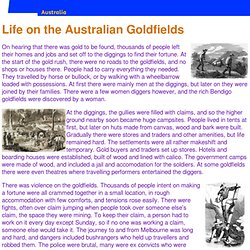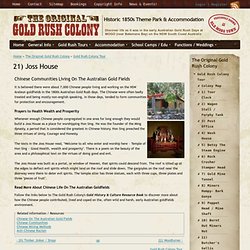

Gold Rushes in Australia - sjmglobal. There were three main goldrushes in Australia.

Australia's Gold Rush in pictures. THE EARLY 1870S WAS a surreal period of Australia’s history.

The Gold Rush had seized the nation. Make-shift towns were springing up throughout New South Wales and Victoria, to support miners seeking wealth and prosperity. It was around this time that German-born entrepreneur Bernhardt Otto Holtermann set up shop at Hill End, near Bathurst, NSW. Holtermann made a fortune mining gold, and discovered what is known as the Holtermann Nugget, the largest specimen of gold ever found. It was 1.5m long and weighed 286kg.
But Holtermann's true legacy lies in a series of photographs he commissioned as a sort of marketing campaign, intended to promote Australian colonies to the rest of the world. English photographer Beaufoy Merlin and his assistant Charles Bayliss took masses of photographs for Holtermann's project, documenting the colonies and pop-up towns including Gulgong and Hill End in New South Wales, which were newly established to support gold diggers. Chinese at the Australian Goldfields. Chinese at the Australian Goldfields At the time that news about the Australian goldrush reached China in 1853, the country had been suffering from years of war and famine.

In order to raise money for the fare to Australia, a man would take a loan from a local trader, agreeing to make regular repayments. His wife and children stayed behind, and worked for the trader if the man was unable to repay the money he had borrowed. To reach Melbourne, it was a journey of several months by ship in cramped conditions. A village in China. The Chinese Gold Rush. While in Beijing last week, I visited the Cai Bai gold market.

China is the largest buyer of gold in the world…and becoming larger by the day. Anecdotally, I can tell you the Cai Bai gold market was bustling with people. (I wish I could show you, but a guard promptly stopped me when I pulled out my video camera.) I was there in the middle of the day, and there was a good crowd of people buying gold in all its forms – from jewelry to bars. The numbers coming out of China back that street-level view. Australian Gold, History & Culture Info - Historic Gold Rush Village Mogo South Coast NSW Australia. Overview - Chinese People Living On 1800s Australian Goldfields - New South Wales The number of Chinese people that came to Australia in the 1800's Gold Rush is open to speculation.

It is believed about 7000 Chinese worked in the Araluen gold fields in Southern NSW. Australia first became multi-cultural during the gold rush period with mass international immigration to Australia. The lure of gold however often took a personal toll on individuals of all persuasions, particularly those who did not speak English. Life on the Australian Goldfields. On hearing that there was gold to be found, thousands of people left their homes and jobs and set off to the diggings to find their fortune.

At the start of the gold rush, there were no roads to the goldfields, and no shops or houses there. People had to carry everything they needed. They travelled by horse or bullock, or by walking with a wheelbarrow loaded with possessions. At first there were mainly men at the diggings, but later on they were joined by their families. Historic 1850s Village Theme Park Tour South Coast NSW - Gold Rush Colony Mogo. It is believed there were about 7,000 Chinese people living and working on the NSW Araleun goldfields in the 1800s Australian Gold Rush days.

The Chinese were often badly treated and being mostly non-english speaking, in those days, tended to form communities for protection and encouragement. Prayers to Health Wealth and Prosperity Whenever enough Chinese people congregated in one area for long enough they would build a Joss House as a place for worshipping Hon Sing. He was the founder of the Ming dynasty, a period that is considered the greatest in Chinese history. Hon Sing preached the three virtues of Unity, Courage and Honesty. The texts in the Joss House read, "Welcome to all who enter and worship here ~ Temple of Hon Sing ~ Good Health, wealth and prosperity". The Joss House was built as a portal, or window of Heaven, that spirits could descend from. Origins: History of immigration from China - Immigration Museum, Melbourne Australia.
Chinese settlers first rushed to Victoria in large numbers hoping to strike gold.

Most were men contracted to agents who sponsored their voyages, and they faced years of difficult repayments. They also sent money back to their families in China. By 1861, the Chinese community was already thriving, making up nearly 7% of the Victorian population. Melbourne’s Little Bourke Street became a bustling centre for Chinese cultural and business activity. As the gold ran out, many Chinese settled as market gardeners or farm hands. Chinese immigration had been restricted by Government policy from as early as the 1850s, but it was the 1901 Immigration Restriction Act – often called the White Australia Policy – that significantly hindered the entry of non-Europeans, including the Chinese, through the use of a dictation test.
Between 1986 and 1991 the China-born population in Victoria more than doubled to over 20,000.